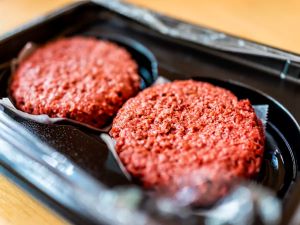Do the Dietary Guidelines for Americans, 2020-2025 Address Meat-like Analogs?
By Reed Mangels, PhD, RD
Dietary Guidelines for Americans is a document that is produced every 5 years and serves as a statement of current federal policy on the role of dietary factors in health promotion and disease prevention. It is used as the foundation for federal nutrition education materials, by schools, the food industry, and many others.
In an earlier post, I stated that the Dietary Guidelines for Americans U.S.-style Dietary Pattern limits total meat, poultry, and eggs to 4 ounces per day for those with a 2200 calorie diet. This prompted a question from a reader about whether the Dietary Guidelines’ provided any similar limit on meat-like analogs. The reader explained that they meant products like Impossible burgers or other meat-like analogs that were not mainly vegetable- or grain-based.
The Dietary Guidelines identifies “core elements that make up a healthy dietary pattern” (1). One of these core elements is the so-called protein foods which includes “lean meats, poultry, and eggs, seafood, beans, peas, and lentils, and nuts, seeds, and soy products” (1). Soy includes “tofu, tempeh, and products made from soy flour, soy protein isolate, and soy concentrate” (1).
While the Dietary Guidelines suggests replacing processed or high-fat meats with beans, peas, and lentils, no suggestions are made for replacing high-fat or processed meat-like analogs. The Healthy U.S.-style Dietary Pattern suggests that those eating a 2200 calorie diet get 5-ounce equivalents a week of nuts, seeds, and soy products. An ounce-equivalent is defined as 1 Tablespoon of nut or seed butters or ½ ounce of nuts or seeds or ¼ cup of tofu. No definition is provided for an ounce-equivalent of soy products other than tofu. The Healthy Vegetarian Dietary Pattern separates their recommendations for soy products and for nuts and seeds. This pattern suggests that those eating a 2200 calorie diet get 8-ounce equivalents a week of soy products but, again, no explanation is provided of what an ounce equivalent is for anything except tofu.
With greater use of a variety of soy products, including processed meat-like analogs, additional dietary guidance is needed on recommended amounts and serving sizes of these products.
Reference
- U.S. Department of Agriculture and U.S. Department of Health and Human Services. Dietary Guidelines for Americans, 2020-2025. 9th Edition. December 2020. Available at DietaryGuidelines.gov.
To read more about Dietary Guidelines in the United States see:
What Have the U.S. Dietary Guidelines Said About Vegan and Vegetarian Diets? A Look Back
2020=2025 Dietary Guidelines for Americans Released; Has Both Positive and Negative Features
2015-2020 Dietary Guidelines Released
2010 Dietary Guidelines Released
To read more about Dietary Guidelines in other countries see:
Do International Dietary Guidelines Promote Vegan/Vegetarian Diets?
Mexican 2023 Dietary Guidelines Recommend that 92% of our Plate Should be Plant Foods
Spain’s Dietary Recommendations: Less Meat, More Plant Foods

